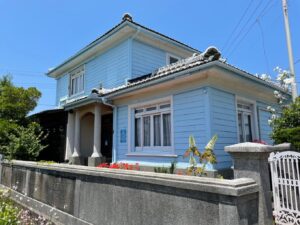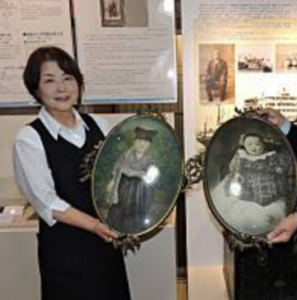カナダ・ミュージアムについて

明治以来、美浜町三尾はカナダへ多くの移民を送り出した地域であり、その移民した人達が帰国後にカナダでの暮らし、文化を三尾に根付かせました。
又、そのシンボルでもある民家をカナダミュージアムとして彼らの歴史と地域にもたらした文化、カナダでの足跡を展示し、その軌跡を後世に伝えていく施設です。
カナダ・ミュージアムのパンフレット情報は下記よりご覧くださいませ。
カナダ・ミュージアムのアクセス

大阪・京都方面から電車で来られる場合:JR新大阪駅もしくはJR大阪駅から特急くろしお(全席事前予約制)にて、所要時間約1時間50分。
JR御坊駅にて下車。JR御坊駅からは熊野御坊南海バス日の岬パーク線海猫島行きあるいはタクシーで約20分、バス停アメリカ村下車徒歩1分。
※You need to get to JR Gobo Station first when going to Mio. From JR Gobo station, you can take a taxi or bus to go to Mio.
Bus timetable (JR Gobo Station → America-Mura)
Hinomisaki Park Line as of October in 2022
Depart from Gobo → Arrive at America-Mura
8:05 8:26
9:30 9:51
11:10 11:31
12:20 12:41
15:00 15:21
16:05 16:26
17:05 17:26
カナダ・ミュージアムのスタッフ

館長「三尾たかえ(みお・たかえ)」(Director, Takae Mio)

1951年、和歌山県日高郡美浜町三尾に生まれる。カナダとの関係は、明治末に祖父の妹が三尾から移民した漁師の夫と結婚してスティーブストンに住んだことから始まった。その後も叔母家族とは頻繫に交流が続いていたが世代交代とともにいつしか関係性は途切れていった。2011年に仕事を定年退職後、一足先に会社勤めから漁師となっていた夫の11月~3月までの伊勢エビ漁を手伝っていた2017年に、美浜町地方創生事業が始まり、2018年、三尾地区にNPO法人日ノ岬・アメリカ村が設立され、カナダミュージアム担当理事に就くと共に代表となる。ミュージアム設立から5年が過ぎ、カナダ移民送出地の拠点施設として、さらにローカルミュージアムとしての役割が求められている。また、カナダ側研究者、日本側研究者、地域在住者とも連携しながら「出移民史を通じた次世代育成のための地域密着型パブリック・ヒストリーの構築」を研究目的とした科研共同研究が始まり地域住民として参加していることで、子供の頃からのイメージであるステレオタイプのカナダへ移民した人々の姿が、別な面からより深く見ることができるようになった。その共同研究の成果物が日本とカナダの地域の人々にもたらされるよう努力したい。
Takae Mio was born in 1951 in Mio, Mihama-cho, Hidaka-gun, Wakayama Prefecture. Her relationship with Canada began at the end of the Meiji era when his grandfather’s sister married a fisherman husband who emigrated from Mio and lived in Steveston. After that, she continued frequent exchanges with her aunt’s family, but the relationship was somehow severed with the generational change. After retiring from work in 2011, she helped her husband, who had become a fisherman one step ahead of her from his corporate job, with lobster fishing from November to March. in 2017, the Mihama Town Local Development Project was started, and in 2018, NPO Hinomisaki America-mura was established in the Mio area, and she took on the role of Director in charge of the Canada Museum and became its representative. Five years have passed since the establishment of the museum, and it has been served as a base facility for the Canadian immigrant sending area, as well as a local museum. In addition, a joint research project on the “community-based public history in Mio for fostering the next generation” was started in cooperation with Canadian and Japanese researchers and local residents, and she has been participating as a local resident. She hopes to make an effort to bring the products of this joint research to the descendants Mio migrants both in Japan and Canada.